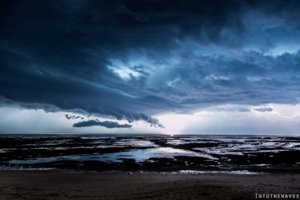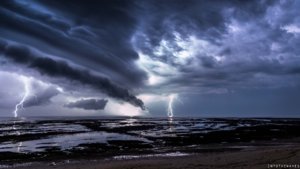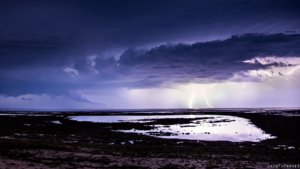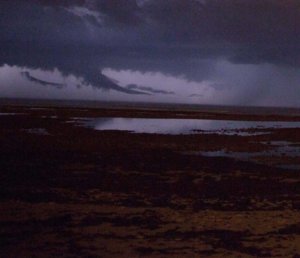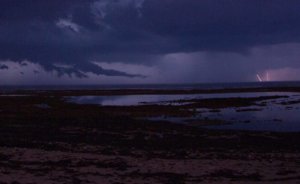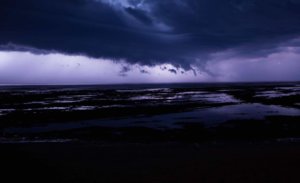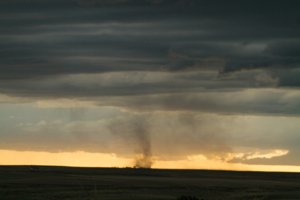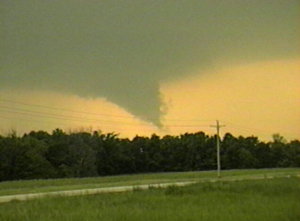After rereading this thread, I would have to agree the feature in question is a gustnado/landspout hybrid, as others have already labeled it. That‘s if you absolutely have to have a category for it. Some events just aren’t going to be 100% classifiable as being precisely this type or that type of tornado.
Contrary to what we are taught regarding catagorising these events; There will continue to be events like this that are contrary to the rule! Most gust front tendrils that I have witnessed do not rotate, BUT some did!
Yep, they sometimes do, and I’ve seen enough weird spin-ups over the years to make me think this kind of thing happens more often than you might think. For instance, I once observed an advancing gust front that had several low hanging fingers of condensation, kinda like the 2nd picture in Rejean Boudreau’s post above, the one labeled “Few minutes later, scuds are forming…†There was no rotation in the tendrils at first, but one of the scud fingers was bigger and out ahead of the others, enough to make me take notice of it and watch for a while. This finger became almost stationary as it began to thicken, eventually becoming a stout cylinder of condensation that reached from the cloud base all the way to the ground... But clearly NOT rotating, not to begin with. To my amazement, as I watched it began to rotate cyclonically, extremely slowly at first, but with increasing speed. The rotation began at the top part of the finger, right at the cloud base, and gradually worked its way down, so that in a few minutes the whole formation was spinning - in fact it soon began to spin quite fast! Almost before I knew what was happening, I realized I was staring at a violently rotating column of air attached to both the cloud base and the ground: the textbook definition of a tornado. I was quite close, and at that time I had little experience being around tornadoes, so even though there was minimal forward motion I became concerned for my safety. I got back into my car intending to drive to a safer position, but as I drove away heavy rain began to fall, and when I tried to look back to see what was happening the formation had vanished in the rain. I was unable to spot it again, despite some rather frantic driving around, so probably it dissipated when the rain came. I subsequently spoke to someone who had been watching the same feature from a different direction, and he confirmed the evolution and strangeness of the thing. He saw exactly what I saw, but what was it?
What do you call a big scud finger that’s all the way in contact with the ground but clearly not rotating, that then begins to spin as you watch it? I would say it’s not a gustnado, despite occurring on a gust front, because it was almost stationary. Gustnadoes typically form from eddies, but this gust front had stalled, there simply wasn’t enough motion to generate an eddy of that type. So, landspout, then? Perhaps, but only if you use a definition of exclusion, where landspout means any non-mesocylonic tornado. There was no rotating wall cloud that I could see, the parent cloud was pretty clearly a shelf cloud, and not even an RFD shelf - at least I don’t think it was, back then I was pretty ignorant when it came to storm structure. Looking back now, I would have to guess it was a relatively disorganized forward-flank shelf cloud. The parent cell was part of a line of storms, not especially violent, and very unlikely to have been supercellular, although I can’t say for sure there wasn‘t a transient hidden mesocylone. As for the vortex itself, I don’t know what you would call it, it started as a gust front tendril but at the end it absolutely fit the definition of a tornado. Heck, at that point it was scary enough to make me fear for my safety. It sure
looked like a tornado, once it got going... It’s only the strange way it evolved that calls the tornadic classification into question. I never reported it, although someone else may have, as I mentioned there were other witnesses. To my knowledge there was never any damage reported. A very strange event, one that I’ll probably never know the truth about, but clearly it doesn’t fit comfortably into any of the known categories of tornadic vortex. I would guess the spin-up in France is similarly unclassifiable.













